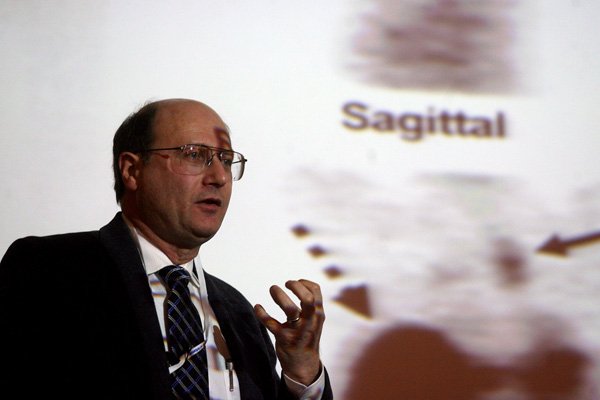FAYETTEVILLE — In their pursuit of a cure for cancer, many scientists have succeeded in part, but the larger puzzle itself still defies a solution, researchers attending a national symposium said Thursday.
An unconventional approach is needed, Vanderbilt University professor John P. Wikswo told science colleagues assembled at the University of Arkansas.
“We’re drowning in a sea of data,” he said during the Breast Cancer Research Workshop, which began Tuesday and concludes today. “People are finding genes much more rapidlythan they’re finding the expressions that these genes drive.”
Wikswo - whose fields include biomedical engineering, physics, molecular physiology and biophysics - said experiments would be simpler if there was only a linear effect from animal to organ to cell to protein, and from the animal’s genome to the genome’s molecular makeup.
One of his slides listed those things in a stair-step progression, but the next added a maze of arrows going from one to another in many confusing patterns, suggesting the complex effects that testing of a newprocedure or cancer drug can have throughout the animal’s system.
“Many of the interactions are nonlinear,” Wikswo said, and solving a problem for the cell of a single mammal could require as many as 1 million experiments. Problem is, people aren’t that smart or that fast, he said, so he and his colleagues are turning to algorithms to feed into supercomputers, as well as robotics, to solve many equations.
“The human can only process seven different problems at a time,” Wikswo said.
A dozen national and Arkansas speakers are participating in the workshop. On Wednesday and Thursday, participants heard from Dr. Suzanne Klimberg, director of the breast cancer program at the Winthrop P. Rockefeller Cancer Institute of the University of Arkansas for Medical Sciences.
The medical school announced last November that Klimberg’s Atlas of Breast Surgical Techniques had been published. The 440-page reference is aimed at surgeons, surgical residents and medical students, and the many techniques described in its pages include two that Klimberg developed at UAMS.
One of them, axillary reverse mapping, or ARM, addresses a common side effect of breast cancer treatment: lymphedema, a swelling of the arm caused by faulty drainage of the lymph nodes. Klimberg’s ARM technique evaluates the ways in which fluid drains through the lymph node system in the arm using an injected blue dye. This lessens the chance that the surgeon will accidentally disrupt the lymph node system during the procedure, thus reducing the likelihood of lymphedema.
Another of Klimberg’s techniques is a tumor excision followed by radiofrequency ablation, or eRFA.The surgeon inserts a probe and heats it to 100 degrees for about 15 minutes. This burns the tissue surrounding the tumor cavity, creating a 1-centimeter zone of dead tissue. By giving the patient a cancer-free area around the site that once housed the tumor, a second surgery in that spot can be avoided.
Also Thursday, Michael Borrelli of UAMS spoke about scanning technologies for breast cancer.
One new technology will provide images of the breast from horizontal, vertical and diagonal angles for one composite shot that will provide more detail.
“Ladies, it looks like you’re in for much more torture, but that’s what they need to do to read the tumors,” he said.
Northwest Arkansas, Pages 9 on 10/29/2010

